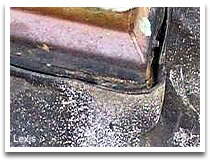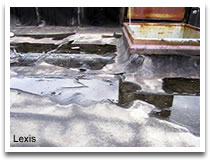Membrane degradation due to exposure to chemicals, oils and UV is a concern with modified bitumen.
Common Issues

|

|

|
|
|
Alligatoring - Cracking of a membrane roof producing a pattern similar to an alligator's hide. Granule loss accelerats this condition unless the membrane is protected by a roof coating. |
Seam Failure - Open and unadhered seams are often the caused by improper torch application. They must be repaired immediately while the membrane is still in good condition. |
Roof Ponding - Retention of water on a caused by inadequate roof drainage or structural deflection. Water can enter failed seams or punctures and cause leaks. |
Modified Bitumen RoofingAsphalt degradation is a growing concern. UV-rays oxidize the surface of the asphalt and produces a chalk-like residue. As plasticizers leach out of the asphalt, a modified bitumen or "mod bit" roof becomes brittle. Cracking and alligatoring inevitably follows, allowing water to penetrate the system causing blisters, and cracks. Seam failure inevitably follows causing leaks. Leaks in modified bitumen roofs are difficult to isolate and a seamless roof coating system is a cost effective solution. The surfacing of the sheets is also a maintenance concern. Modified Bitumen sheets are not as sensitive to ultraviolet light as built up roofs but there is still degradation. Studies have indicated that a reflective coating applied within five years of installation can extend the service life of the membrane by 10 or more years. Water-borne or solvent-borne roof coatings may be used. However, a solvent-based coating offers greater resistance to ponding water. Learn more about Modified Bitumen Roof Repair or Modified Bitumen Roof Coating. Modified Bitumen Roof Coating & RestorationAdd 10 or more years to your built up roof with our modified bitumen roof restoration system. Get a seamless roof without costly tear off and disruption. Stop roof leaks and prevent further degradation.
|
What is Modified Bitumen?A modified bitumen roof system is a hybrid built-up roof. It has the benefits of the built in redundancy of the BUR, along with the added strength, flexibility and UV resistance of a modified membrane. Modified Bitumen or "modbit" membranes consist of an asphalt and polymer blend which allow the asphalt to take on characteristics of the polymer. There are several surfacing option for this system which include a factory applied mineral surface, a gravel surface laid in bitumen or a liquid applied coating that is typically reflective in nature. Typical lifespan of a modified bitumen roof is 10 to 20 years depending on weather conditions. Types of Modified Bitumen RoofAPP Modified Bitumen, SBS Modified Bitumen (Smooth or Granulated) Reflectivity of Modified BitumenThe solar reflectivity of Modified Bitumen Roofs depend on the color of the surface layer. Dark modified bitumen roofs can reach 150°F or more in the summer. A black modified bitumen roof absorbs a lot of the sun's heat in the summer. High temperatures and UV-rays accelerate asphalt degradation. To make matters worse, the heat build up raises plenum temperatures thereby increasing cooling costs in the building. Elastomeric coatings provide the highest reflectivity and is a very popular option for building owners. White roof coatings can reflect up to 90% of the heat from the sun. |









